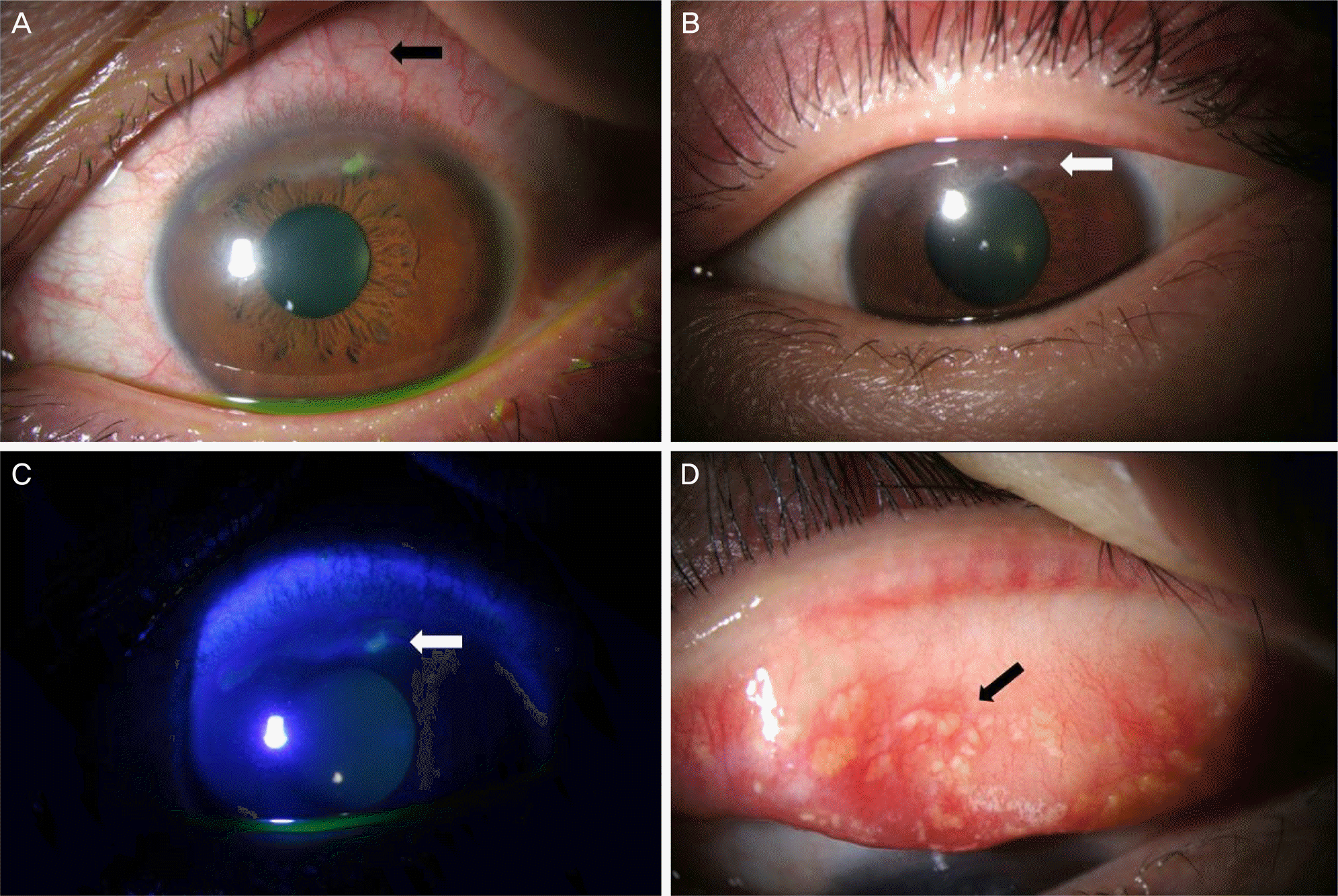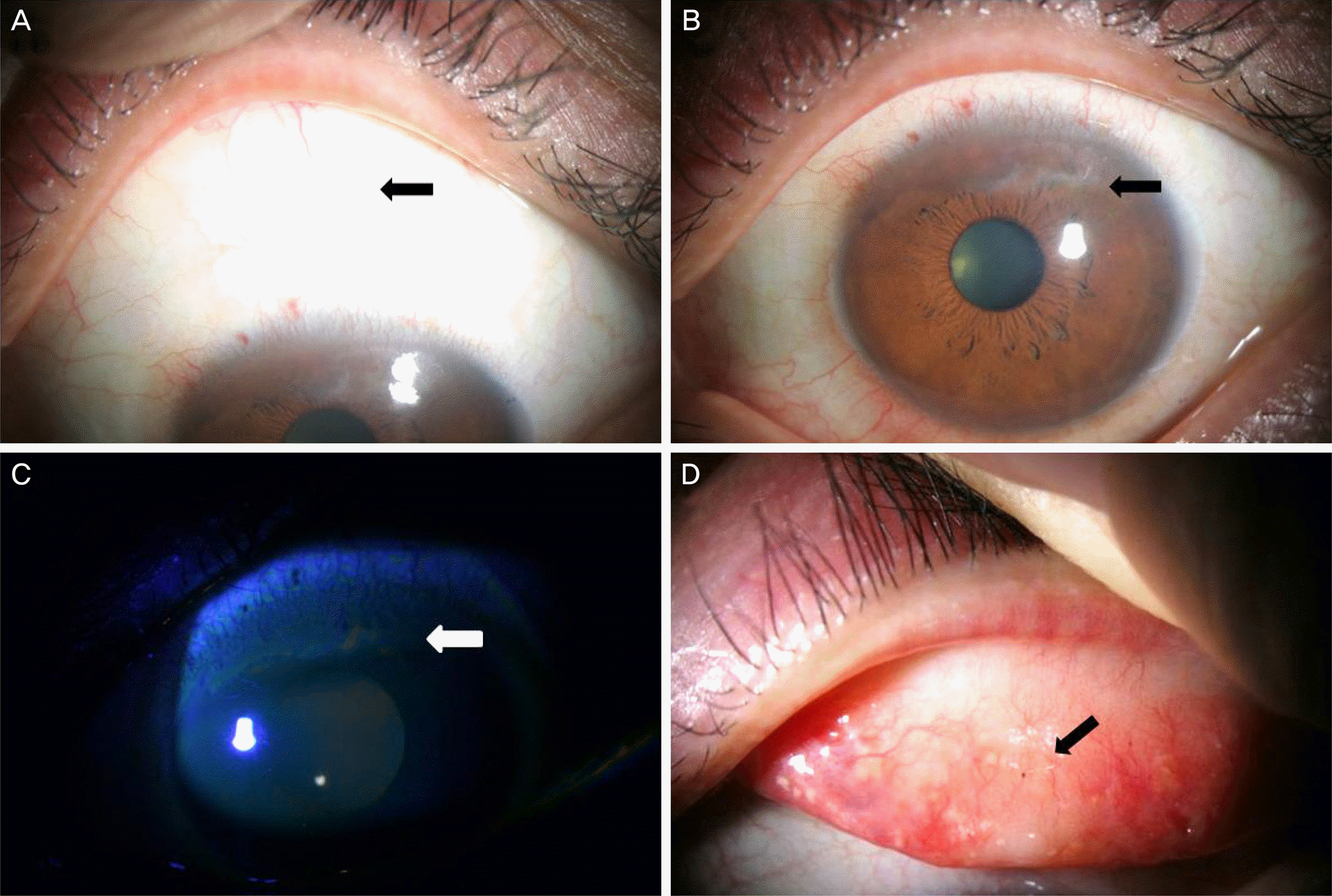Abstract
Purpose
To report a case of conjunctival lithiasis with clinical manifestations of superior limbic keratoconjunctivitis.
Case summary
A 40-year-old male complained of pain, foreign body sensation and injection in the left eye lasting 1 month. The slit-lamp examination revealed injection of the superior bulbar conjunctiva, linear corneal band opacity, fine punctate staining and epithelial defect in the superior cornea area. After eversion of the left upper eyelid, there were many various-sized conjunctional concretions and inflammation in the superior tarsal conjunctiva. Therefore, we considered conjunctival lithiasis-induced clinical manifestations of superior limbic keratoconjunctivitis and then removed the conjunctival concretions using a 30-gauge needle. After the procedures, artificial tears, antibiotic eye drops, steroid eye drops and a therapeutic contact lens were applied. After 1 week, all symptoms and signs improved and there was no recurrence for 4 months.
Conclusions
Mechanical stimulation by severe conjunctival lithiasis can induce clinical manifestations of superior limbic keratoconjunctivitis. Therefore, in patients with clinical manifestations of superior limbic keratoconjunctivitis, conjunctival lithiasis should be considered by observing the superior tarsal conjunctiva more closely.
References
1. Kim HB, Kweon E, Lee JB. Superior limbic keratoconjunctivits. J Korean Ophthalmol Soc. 1981; 22:395–8.
3. Bainbridge JW, Mackie IA, Mackie I. Diagnosis of Theodore's abdominal limbic keratoconjunctivitis. Eye (Lond). 1998; 12(Pt 4):748–9.
4. Cher I. Superior limbic keratoconjunctivitis: multifactorial abdominal pathogenesis. Clin Experiment Ophthalmol. 2000; 28:181–4.
5. Matsuda A, Tagawa Y, Matsuda H. TGF-beta2, tenascin, and in-tegrin beta1 expression in superior limbic keratoconjunctivitis. Jpn J Ophthalmol. 1999; 43:251–6.
6. Chin GN, Chi EY, Bunt AH. Ultrastructural and histochemical studies of conjunctival concretions. Arch Ophthalmol. 1980; 98:720–4.

7. Duke-Elder S. System of Ophthalmology. St Louis: CY Mosby;1965. p. 585–6.
8. Theodore FH, Ferry AP. Superior limbic keratoconjunctivitis. abdominal and pathological correlations. Arch Ophthalmol. 1970; 84:481–4.
9. Kadrmas EF, Bartley GB. Superior limbic keratoconjunctivitis. A prognostic sign for severe Graves ophthalmopathy. abdominal. 1995; 102:1472–5.
10. Wilson FM 2nd, Ostler HB. Superior limbic keratoconjunctivitis. Int Ophthalmol Clin. 1986; 26:99–112.

11. Wright P. Superior limbic keratoconjunctivitis. Trans Ophthalmol Soc U K. 1972; 92:555–60.
12. Sheu MC, Schoenfield L, Jeng BH. Development of superior abdominal keratoconjunctivitis after upper eyelid blepharoplasty surgery: support for the mechanical theory of its pathogenesis. Cornea. 2007; 26:490–2.
13. Raber IM. Superior limbic keratoconjunctivitis in association with scarring of the superior tarsal conjunctiva. Cornea. 1996; 15:312–6.

14. Mackie IA. Management of superior limbic keratoconjunctivitis with botulinum toxin. Eye. 1995; 9(Pt 1):143–4.

15. Chun YS, Kim JC. Treatment of superior limbic abdominal with a large-diameter contact lens and Botulium Toxin A. Cornea. 2009; 28:752–8.
16. Chang SW, Hou PK, Chen MS. Conjunctival concretions. Polariz-ed microscopic, histopathologic, and ultrastructural studies. Arch Ophthalmol. 1990; 108:405–7.
17. Wilson RP. The pathology of trachoma. Bull Ophthalmol Soc Egypt. 1936; 29:1–5.
18. Haicl P, Janková H, Jirsová K. Dry eye syndrome in patients with conjunctival concretions. Cesk Slov Oftalmol. 2006; 62:415–22.
19. Haicl P, Janková H. Prevalance of conjunctival concretions. Cesk Slov Oftalmol. 2005; 61:260–4.
20. Kulshrestha MK, Thaller VT. Prevalence of conjunctival concretions. Eye (Lond). 1995; 9(Pt 6):797–8.

21. Kim KY, Lee YS, Lee HJ, et al. A case of conjunctival lymphangio-ma with clinical manifestations of superior limbic abdominal after upper lid blepharoplasty. J Korean Ophthalmol Soc. 2010; 51:1276–81.
Figure 1.
Slit lamp photographs of the left eye at initial presentation. There are superior sectoral bulbar conjunctival injection (arrow) (A), a linear corneal band opacity (arrow) (B), a fine punctate staining and epithelial defect (arrow) (C). Multiple vari-ous-sized concretions and Inflammation are observed on the superior tarsal conjunctiva (arrow) (D).

Figure 2.
Slit lamp photographs of the right eye at initial presentation. There is no specific abnormalities in the cornea and conjunctiva (A). Very few concretions are observed on the superior tarsal conjunctiva (arrow) (B).

Figure 3.
Slit lamp photographs of the left eye at 4 months. Superior bulbar conjunctival injection disappeared (arrow) (A). A linear band opacity (arrow) (B), punctate epithelial erosions improved and epithelial defect completely recovered (arrow) (C). Most of concretions were eliminated and inflammation resolved on the superior tarsal conjunctiva (arrow) (D).





 PDF
PDF ePub
ePub Citation
Citation Print
Print


 XML Download
XML Download